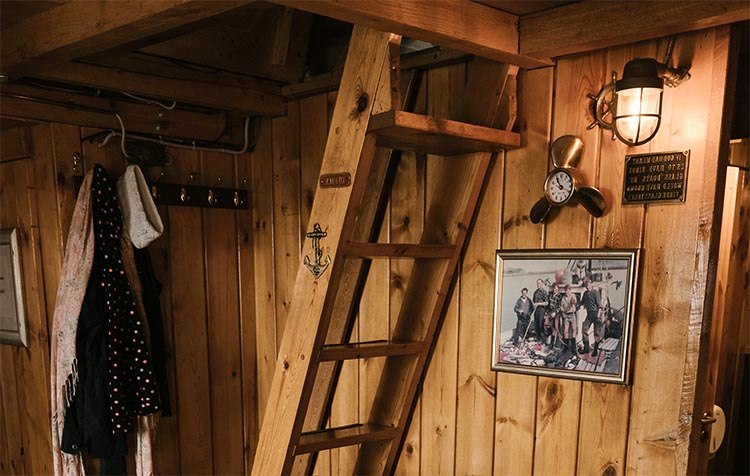Contents
- 1 What Is an Attic Ladder?
- 2 Why Do You Need to Measure for an Attic Ladder?
- 3 What Tools Do You Need to Measure for an Attic Ladder?
- 4 Step-by-Step Guide on How to Measure for an Attic Ladder
- 5 What Are the Standard Sizes for Attic Ladders?
- 6 How to Choose the Right Attic Ladder Size?
- 7 What Are the Common Mistakes When Measuring for an Attic Ladder?
- 8 Frequently Asked Question
Thinking about adding an attic ladder to your home but unsure how to measure for an attic ladder to ensure a perfect fit?
Accurate measurement for an attic ladder is essential to ensure a proper fit and safe access to your attic space.
This guide provides comprehensive information, detailing the necessary tools required as well as the specific measurements you should take.
It also emphasizes common mistakes to avoid and offers guidance on selecting the appropriate size. Prepare to acquire the knowledge needed to master the art of attic ladder measurement.
What Is an Attic Ladder?
An attic ladder is a specialized access solution intended to facilitate safe and convenient entry to storage spaces situated in the attic.
These innovative ladders are available in various styles, including retractable and folding options, making them an essential feature for homeowners aiming to optimize their attic design with a focus on both functionality and safety.
Along with improving attic access, they also contribute to overall home enhancement by maximizing usable space in constrained areas.
Homeowners looking to understand how to measure for an attic ladder should carefully evaluate the installation process and select a ladder that aligns with their attic dimensions and design preferences.
Why Do You Need to Measure for an Attic Ladder?
Accurate measurement for an attic ladder is crucial to ensure a proper fit and safe functionality within the home. This measurement process requires consideration of various dimensions, including ceiling height, attic dimensions, and the size of the opening necessary for effective access to the attic.
By taking precise measurements, homeowners can prevent installation challenges and ensure that the selected ladder type meets the required clearance standards for ease of use and user safety. Inaccurate measurements may result in difficulties during the installation process and could potentially pose safety hazards.
What Tools Do You Need to Measure for an Attic Ladder?
Accurate measurement is essential for a successful attic ladder installation, and several tools are required to ensure both precision and efficiency throughout the measurement process.
The primary tool needed is a tape measure, which facilitates the assessment of various dimensions, including ceiling height, wall height, and opening size.
Utilizing a measurement guide or tool checklist can significantly streamline the DIY project, ensuring that all necessary information is collected before proceeding with the installation. These tools not only save time but also enhance the overall safety and stability of the attic access solution.
When learning how to measure for an attic ladder installation, additional important instruments include a level, which ensures that the ladder will be properly aligned and stable, thereby mitigating potential hazards.
A square is also invaluable for marking precise right angles on the ceiling opening, ensuring a perfect fit.
Furthermore, a stud finder is instrumental in locating the best anchor points for ladder attachment, thereby increasing the strength and durability of the installation.
By employing these tools, homeowners can achieve the accurate measurements necessary for a successful attic ladder installation, thereby fostering a safe and functional access point to their attic space.
Step-by-Step Guide on How to Measure for an Attic Ladder

Measuring for an attic ladder necessitates a systematic approach to ensure that all dimensions are accurately accounted for, allowing the selected ladder to fit properly within the designated space without compromising safety. This step-by-step guide will provide measurement techniques that emphasize precision, facilitating effective navigation of the attic dimensions.
By adhering to the installation instructions typically provided in the user manual, one can ensure that the fitting process is both straightforward and compliant with relevant building codes.
Each step in this process is essential to achieving optimal ladder performance and ensuring user safety within the home.
Step 1 – Measure the Floor-to-Ceiling Height
The initial step in measuring for an attic ladder entails determining the floor-to-ceiling height, which is essential for selecting the appropriate ladder height.
To accomplish this, it is advisable to utilize a tape measure to accurately assess the distance from the attic floor to the ceiling, taking care to account for any variations in ceiling height that may impact the ladder’s performance.
This measurement is critical when learning how to measure for an attic ladder to ensure it can be fully extended and safely utilized without compromising user safety.
It is imperative to conduct a thorough examination of the space, as sloped ceilings or beams may introduce discrepancies that could affect both measurements and user comfort. Employing a level or enlisting the assistance of a second individual can enhance accuracy, particularly in areas where the height may not be uniform.
It is also important to consider the thickness of flooring materials and any attic insulation, as these factors can influence the required height for the ladder.
By taking these factors into consideration, one can proceed with the selection of an attic ladder that meets specific requirements while ensuring safe operation.
Step 2 – Measure the Width of the Attic Opening
It is imperative to measure the width of the attic opening, as this dimension will dictate the appropriate ladder width that can be safely and effectively accommodated.
Assessing the size of the opening ensures that the selected attic ladder will not only fit properly but also fulfill necessary clearance requirements for safe access.
This step is particularly crucial in attics with unique layouts or limited vertical space, as it helps prevent installation errors that could adversely affect both functionality and safety.
To accurately measure the width, begin by using a tape measure to determine the opening from one side to the other.
When learning how to measure for an attic ladder, it is essential to check for any obstructions, such as beams or ductwork, that may influence both the installation and use of the ladder.
In instances where the attic features sloped ceilings or unconventional angles, it is advisable to take multiple measurements at various points to confirm that the widest clearance is available.
Addressing these potential obstacles at the outset can significantly mitigate complications during the installation process.
Step 3 – Check for Any Obstructions
Before finalizing measurements, it is essential to inspect the attic area for any obstructions that may impede the installation of the ladder. This includes assessing the placement of support beams, ductwork, or any framing widths that could obstruct access or compromise the safe use of the ladder.
Failure to identify these barriers not only complicates the installation process but also introduces potential safety risks, as insufficient space may lead to accidents or instability during operation.
Ensuring clear access points is critical – it facilitates the efficient maneuvering of both the ladder and individuals accessing the attic.
A thorough assessment of the space will allow for informed decisions on how to measure for an attic ladder, thereby prioritizing both practicality and safety in the overall setup.
Step 4 – Determine the Rough Opening Size
The final step in the measurement process entails determining the appropriate rough opening size required for the installation of the attic ladder. This measurement necessitates careful consideration of the attic dimensions to ensure that the opening size is compatible with the selected ladder options.
A precisely measured rough opening not only facilitates a smoother installation process but also ensures that the ladder functions effectively within the designated space, thereby enhancing user safety and accessibility.
To commence, it is crucial to measure the width and height of the ceiling joists, as these dimensions will directly inform the required rough opening size.
It is also essential to account for the type of ladder selected, whether it is a folding or telescoping model, as each type possesses unique specifications regarding the opening size.
What Are the Standard Sizes for Attic Ladders?

Attic ladders are available in various standard sizes to accommodate different ceiling heights and attic dimensions, providing versatility for homeowners. The most common ladder heights range from 7 to 10 feet, while widths typically vary from 22 to 30 inches, ensuring a suitable fit for most attic openings.
Understanding these product dimensions is essential when selecting the appropriate ladder style for specific needs, as it can significantly affect the ladder’s load capacity and overall safety during use. Homeowners should familiarize themselves with these standard sizes to make informed decisions.
How to Choose the Right Attic Ladder Size?
Choosing the right attic ladder size is essential for functionality and safety. The process begins with careful and precise measurements of the attic space.
It’s important to accurately assess the area where the ladder will be installed to ensure a perfect fit and to avoid any structural issues.
To make a well-informed decision, several factors should be considered, including the height of the ceiling, the height of the walls, and the intended use of the attic space.
These elements significantly influence the type of ladder that can be installed. When considering how to measure for an attic ladder, it’s important to note that a higher ceiling might require a longer ladder, while a smaller attic entrance could limit the type of ladder you can use.
Additionally, it’s crucial to follow installation tips and guidelines closely.This adherence ensures that the selected ladder not only fits well but also complies with building codes and safety standards.
Knowing these requirements can help avoid common pitfalls that might compromise the ladder’s safety and functionality.
What Are the Common Mistakes When Measuring for an Attic Ladder?

When it comes to measuring for an attic ladder, there are several common errors that can lead to significant installation challenges and potentially dangerous situations.
A frequent mistake is failing to consider variations in ceiling height across different parts of the attic or not accounting for potential obstructions like pipes or ductwork. These oversights can result in choosing a ladder that does not fit properly, creating gaps or instability.
Moreover, the accuracy of your measurements is critical. Using imprecise tools or techniques can lead to errors in ladder fitting.
When learning how to measure for an attic ladder, it’s essential to use a reliable measuring tape and double-check measurements from different sections of the attic to ensure consistency.
Homeowners must be vigilant about these common mistakes. Understanding these issues is vital in selecting the correct ladder size, ensuring the installation is safe and that the ladder functions properly for safe and easy access to the attic.

